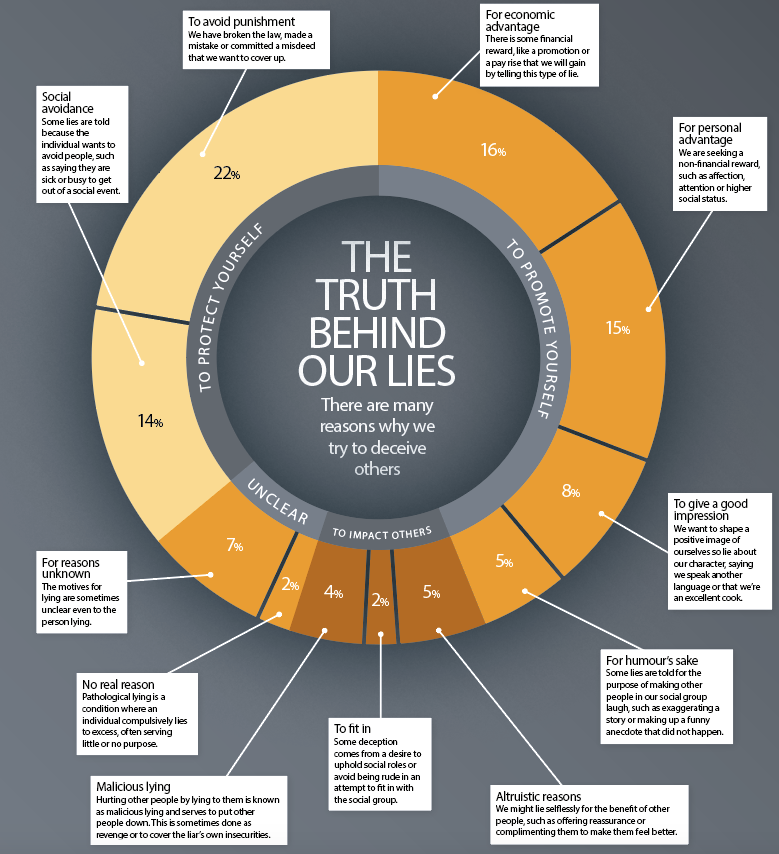Why do we lie?
by Scott Dutfield · 24/05/2020
It’s not just bad behaviour – deception is a product of evolution and it gives your brain a real workout

Your dog really did eat your homework, and you have no idea who took the last biscuit from the sweet jar. Lying is in your nature, but don’t worry – it’s in the nature of most humans. It’s a technique that has evolved over billions of years, so it turns out you might not actually have that much to feel bad about.
Humans are social creatures, and we have our giant brains to thank for this. They evolved to be so large because we needed the extra space to be successful at communicating with others and keeping our social group happy. This has a lot of advantages. If you can build bonds with other humans you can access more resources because your friends and family will share food and shelter, helping you out when you need it. But to keep these close connections sometimes we need to lie. Throughout hominid history it has been a genetic advantage to be a good liar, as it supports social bonds, and therefore you are more likely to survive and pass on your genes. Bending the truth, playing fast and loose with the facts, telling a tall tale – whatever you call it, lying is something that most individuals in our species find really easy.
Although deception is frowned upon by society, it actually evolved as a way to fine-tune our social skills and strengthen our relationships. Have you ever told a friend that you really loved the dinner they had cooked for you? Or maybe you have lied to your mum about accidentally breaking something in the kitchen? That’s these evolutionary mechanisms kicking in, and whether it was to protect your reputation or just avoid upsetting someone, it probably worked well to protect your relationships (if you didn’t get caught that is).
Lying is a creative task, and it’s much harder for our brains than just telling the truth, as it requires remembering lots of different information to keep the story consistent. Even more complicated is our ability to lie to ourselves, an extreme level of deception that requires keeping two pieces of information in our heads and ignoring one.
Whatever reason you are lying, and however complex the lie, there are three main parts of the brain that you use when you are being deceptive: the anterior cingulate cortex, which is responsible for monitoring errors, the dorsolateral prefrontal cortex which controls behaviour, and the parietal cortex, which processes information from your senses. These parts become more active when lying, and they can be seen using functional MRI scanners – a much more advanced version of a lie detector.
However, we’ve not always had the technology to help us detect a liar. For most of history we have relied on our observation and social skills. We learnt how to monitor other people’s behaviours for signs they were not telling us the truth; unusual eye contact, signs they might be sweating more, elaborating on a story with details that just don’t sound believable. As our ability to lie evolved, so did our ability to detect a lie. This has come in helpful because not every lie is told because we want to keep our friends. Sometimes lying is used to manipulate others for personal gains, such as scamming people out of money. Being able to detect a lie is helpful for keeping our resources safe from people who are dishonest.
We’re not the only species that has developed deceptive tactics. The skill has been mastered throughout the animal world, notably by tufted capuchin monkeys, which will shout out false alarms to scare away older individuals from food, and the polka-dot wasp moth, which mimics the same clicks of the bad-tasting delicate cycnia moth to ward off predators. These animals developed these tactics to protect themselves rather than strengthen social bonds.
This article was originally published in How It Works issue 120, written by Charlie Evans
For more science and technology articles, pick up the latest copy of How It Works from all good retailers or from our website now. If you have a tablet or smartphone, you can also download the digital version onto your iOS or Android device. To make sure you never miss an issue of How It Works magazine, subscribe today!





